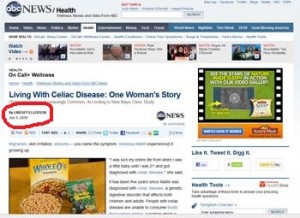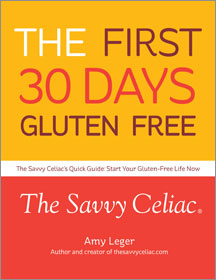If you’re reading this blog you’ve certainly already discovered it. And I’ve definitely lived it. A research paper looks at how people with celiac disease and gluten sensitivity get their news — and the answer is ONLINE BABY!
10 years ago, when I was told my 15-month-old baby had celiac disease, my doctor literally told me to look online for more information. I know I’ve mentioned it before on this blog but I couldn’t even spell celiac disease let alone research the topic. Once I mastered the spelling, the only two sites I found early on was the Celiac Sprue Association and celiac.com. I was able to manage a printable list of “forbidden foods” and a long trip to the grocery store.
Fast forward one decade and there is a lot of information out there. Social media as brought the celiac community together — I have virtually “met” people in the celiac community I likely never would have otherwise encountered without Twitter. And that’s what Hungry for news: How Celiac sufferers learn from media, each other is saying: Move over traditional broadcast and even newspaper journalism. Celiacs aren’t tuned into you for their news — they’re tuned in to Facebook, Twitter, websites and blogs. If you just happened upon this post and you’re not a blog reader it might be time for you to start. The paper is quoted,
“These bloggers behave like a network of citizen journalists, doing the hard work of vetting claims and demanding accuracy of each other, lest someone get sick on bad advice.”
It goes on to say, “Indeed, nearly everyone interviewed suggested traditional news sources are most useful at providing awareness of Celiac to those who don’t have it….with notable exceptions such as The New York Times, those interviewed said established sources rarely are first with news on their topic.” A quick Google search supports this. When the University of Maryland’s prevalence study came out in 2003 showing 1 in 133 Americans had celiac disease, only a handful of mainstream media picked it up: The New York Times, Chicago Tribune, Boston Globe, Associated Press. While broadcast has been a little late to the game in terms of getting content online, there was no mention by broadcasters of this enormous study that really changed the tide of taking this disease seriously.
Another example, the Mayo Clinic’s study on mortality of people with celiac disease. It just came out — announced on Twitter — on July 1, 2009 — so bloggers and the internet took notice plus a few smaller television affiliates. But six days later ABC News was finally on board. Fox News reported it on July 10 and sourced Reuters.com (which posted on the same day) for the report. During a quick search nothing came up on this subject for CBS, CNN, MSNBC, and NBC.
Those are the two biggest stories to come out of the celiac world in the last seven years and they were hardly covered by mainstream media. But if you tuned in to celiac on the internet, you’d find out big celiac or gluten-free news pretty quickly.
The paper also notes that people are no longer subscribing to magazines because they can get pertinent information more quickly on Twitter.
In conclusion, the paper notes: “Many [newly diagnosed celiacs] were astonished by how helpful this community they never knew existed could be to them. Whether by blog, Twitter feed or simple Web site, the community members recommended their peers as an important resource for both information and support, preferring them for immediacy and understanding of the gluten-free lifestyle.”
I became interested in reading this after I saw the National Foundation for Celiac Awareness had linked to it. It appears to have been prepared for the Civic and Citizen Journalism Interest Group for presentation at the 2010 AEJMC (Association for Education in Journalism and Mass Communication’s Conference in Denver. It turns out the paper cited my blog on something too! Pretty cool. Please check it out!
Tags: blogs, celiac, gluten-free, internet, media, news, research




Leave a Reply